Quick List X
 First, a general note: as some of you may know, I'm in the process of turning BLDGBLOG into a book for Chronicle Books. That's due out in Spring 2009.
First, a general note: as some of you may know, I'm in the process of turning BLDGBLOG into a book for Chronicle Books. That's due out in Spring 2009. Accordingly, over the next three or four months, until the manuscript is due, I'll be cutting back a bit on posting, going down to maybe two or three times a week... But that's only till February! After which I'll have a bright, new book waiting to be designed by the wizards at Chronicle.
So keep coming back – but be aware that I won't be posting everyday. And buy a copy of the book!
Second, I haven't done a Quick List in a long time, so I thought I'd take a casual swing through some recent stories...
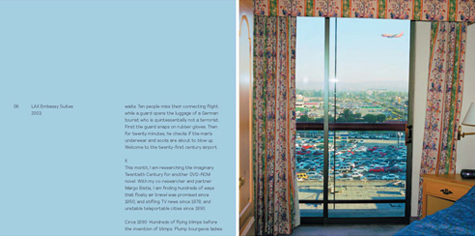 [Image: Zoe Crosher's new pamphlet, published by the LA Forum].
[Image: Zoe Crosher's new pamphlet, published by the LA Forum].In other bookworld news, for instance, the LA Forum has just put out a new pamphlet, featuring photographs of Los Angeles International Airport taken by artist Zoe Crosher.
But the images have a catch: all of the photos were taken inside airport hotel rooms.
- Zoe Crosher takes the viewer on an exploratory journey inside the impersonal and transient travel world surrounding the mega international airport, LAX. She finds a landscape packed with identical hotel chains pushed up against giant billboards, where the words "hotel" and "taxi" are understood by nearly everyone. (...) The pattern[s] of the drapes change, the color of the stucco exterior changes and the airplanes caught in mid flight move through the atmosphere, but the basic view stays the same. There is a haunting familiarity that one has never really left the first room...
In other book news, readers of BLDGBLOG's recent 2-part interview with Mary Beard may be pleased to hear that Beard's Wonders of the World series just got one book bigger.
Keith Miller's St. Peter's just arrived at my house this afternoon.
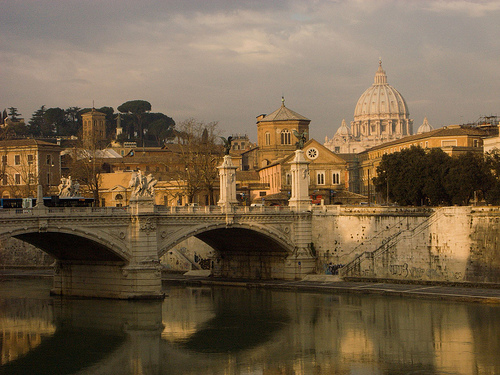

 [Images: (top) A wonderful – stunning! – photo of Rome, with the dome of St. Peter's catching sunlight in the background, by George O. Goodman; (middle) A view inside St. Peter's nested domes and arches by Andrew Huxtable; (bottom) St. Peter's Square, photographed by mambo1935].
[Images: (top) A wonderful – stunning! – photo of Rome, with the dome of St. Peter's catching sunlight in the background, by George O. Goodman; (middle) A view inside St. Peter's nested domes and arches by Andrew Huxtable; (bottom) St. Peter's Square, photographed by mambo1935].Speaking of architectural history, an "underground monastery dating back to the 17th century has been restored in West Russia's Belgorod region. The huge underground complex, which was looted and destroyed after the October Revolution, was sanctified again by the local Archbishop."
- The combined length of the caves is over 650 meters, and they resemble a real labyrinth. But the central part looks like any Orthodox Christian church and there are passages around the site for religious processions. The monastery is dry and temperatures inside remain stable year round at about 6 degrees Celsius.
I believe this is the same place – and if you like this kind of thing then don't miss BLDGBLOG's look at the allure of the underground city.
Moving in the opposite vertical direction, 33 Thomas Street, in New York City, is a windowless concrete high-rise built solely for the purpose of housing a telephone exchange.
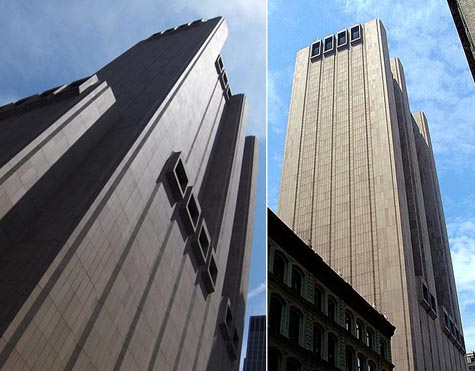 [Image: 33 Thomas Street, via Wikipedia; view slightly bigger].
[Image: 33 Thomas Street, via Wikipedia; view slightly bigger].According to Wikipedia, 33 Thomas Street "is a telephone exchange or wire center building which contains three major 4ESS switches used for interexchange (long distance) telephony, two owned by AT&T and one owned by Verizon."
Further, "As it was built to house telephone switching equipment, the average floor height is 18 feet (5.5 meters), considerably taller than in an average high-rise. The floors are also unusually strong, designed to carry 200 to 300 pound per square foot (10 - 15 kPa) live loads."
Really a gigantic pseudo-Brutalist vault, the building is probably crawling with government wire-tappers – its windowless walls and concrete geometry the subject of at least half a dozen occult urban myths.
For instance, the ghost of Aleister Crowley is said to live there, sitting cross-legged in "a mass of blue and violet plumes," performing divine telegraphy, sending messages into the ether, "crowned with the stars of night."
 [Image: The fires of chromosomal mutation burn].
[Image: The fires of chromosomal mutation burn].Then there was some news about artificial life: "Craig Venter, the controversial DNA researcher involved in the race to decipher the human genetic code, has built a synthetic chromosome out of laboratory chemicals and is poised to announce the creation of the first new artificial life form on Earth." The Guardian refers to this as "a giant leap forward in the development of designer genomes."
All of which is certainly interesting in and of itself, but what might this news herald for the future of landscape architecture? Could someone genetically engineer entire gardens and flowering species, new trees, shrubs, and lichen?
Let's ask Brazil, where the New York Times reports that "sprawling labs and experimental fields" run by the government have been making "Brazil's savannah bloom."
We learn that most of these sprawling labs' "pioneering work" has been performed "in the cerrado, the vast savannah that stretches for more than 1,000 miles across central Brazil. Written off as useless for centuries, the region has been transformed in less than a generation into Brazil’s grain belt, thanks to the discovery that soils could be made fertile by dousing them with phosphorus and lime" – chemically conjuring fertility from the ground.
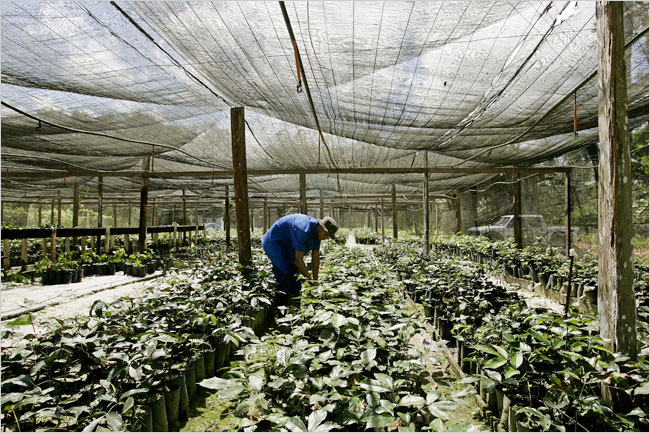
 [Images: The future of the Brazilian Earth, photographed by Lalo de Almeida for New York Times].
[Images: The future of the Brazilian Earth, photographed by Lalo de Almeida for New York Times].But making the Earth more fertile is sometimes just a matter of better harvesting techniques: Pruned introduced us last month to a new breed of picking machines that may soon be set loose upon the American agricultural landscape, harvesting fruits with an efficiency human hands can't quite – apparently – achieve.
But what might happen if these future machines get hacked? What strange new incisions in the landscape might result? Or, "[e]ven more interesting," Pruned asks, "what will happen if they become self-aware and go out to pasture? Fitted with solar panels, grazing from one oil well to another, domiciling in abandoned gold mines, what new ecologies will they terraform?"
This becomes, yes, even more interesting when you add another article – also discovered via Pruned – about the strategic use of crops as a form of pharmaceutical cultivation:
- Conventional ways to make modern medicines are expensive, which means pharmaceutical companies generally target those diseases that affect lots of people who can pay. Plants can be grown, harvested, and the useful medicine purified from them at a fraction of the price, so using them as leafy drug factories saves a fortune, and opens the doors to treating people in poorer countries. Advocates say just 250 acres of GM potato crop could churn out enough hepatitis B vaccine to protect the entire population of south-east Asia from the disease for a year.
But this scientized approach to the public health of tomorrow is not without its controversies. Later in that same article we read that one medically-augmented strain of tobacco is now being cultivated on "a Kent farm, in ultra-secure greenhouses with twin-skin plastic walls strong enough to resist a hurled brick." These ultra-secure greenhouses "are the botanic equivalent of the containment facilities used by microbiologists to work on biological weapons."
In other words, the current legal climate surrounding these Hippocratic organisms means that they will be "swaying only in an artificial, heavily filtered breeze" for some years to come. So much for my visions of the pharmaceutical future...
Until the harvesting machines show up.
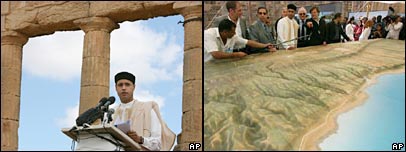 [Images: Libya's ambitious plan is announced; via the BBC].
[Images: Libya's ambitious plan is announced; via the BBC].Further afield, it was announced last month that British architect Norman Foster will be designing a new "eco-region" for Libya – whether they want him to or not...
For that project, Foster + Partners have drawn up "regional plans to create a national park, a renewable energy infrastructure, a public transportation infrastructure fuelled by biofuels, sustainable agriculture irrigated through desalination plants, and an eco-tourism resort. The latter could, according to some preliminary plans, have buildings built into the side of mountains to minimise their visual impact and take advantage of the stone's insulating properties."
As the Guardian points out, the project's brief "basically says everything the world would want to hear: sustainable development; archaeological conservation; eco-tourism; renewable energy; environmentally responsible town planning; micro-banking; education; biofuels; even production of 'the finest quality organic food and drink'."
Further:
- Foster's plan strives to avoid turning the coastline into another Benidorm. Nothing will be built along the seafront; all will be pushed back to the foot of the hills. Controlled zones of forest and agriculture will rise up the hills inland, towards the ruins on the plateau above. New towns will be based on the traditional Arab medina model: close-knit communities to minimise car use and urban sprawl.
Just today, then, the New York Times jumps in, calling Foster's eco-region "a carbon neutral green-development zone, catering to tourism and serving as a model for environmentally friendly design," complete with "luxury hotels, villas and golf courses, as well as community housing."
Sounds green, indeed! I'll fly there in my private jet and recycle Pepsi cans.
Lots of Pepsi cans.
 [Image: A rendering of the Libyan eco-region, ©Foster + Partners, via the New York Times].
[Image: A rendering of the Libyan eco-region, ©Foster + Partners, via the New York Times].Moving outward, then, New Scientist asks: "Did ancient oceans on Venus last long enough for potential life to have emerged? The answer could be locked inside a hardy mineral called tremolite, which future robotic missions to our neighbouring planet could find and study."
After all, the "surface of Venus today is extremely dry and hot enough to melt lead," but at some point in the distant past it may have harbored seaborne life.
Perhaps Norman Foster can build a resort there.
 [Image: A Venusian mountain called Maat Mons; via New Scientist].
[Image: A Venusian mountain called Maat Mons; via New Scientist].However, if Venus doesn't interest you there are always "Super-Earths" – "rocky planets up to 10 times the mass of Earth." 10 times! Imagine the canyons, and the mountains, and the caves!
Because of those planets' mass, we read, plate tectonics are apparently "inevitable." Further: "Plate tectonics may boost biodiversity by recycling chemicals and minerals through the crust. 'When it comes to habitability, super-Earths are our best destination,'" we're told – and "life" is just geochemistry in a slightly more mobile form. We're just pieces of the Earth's surface.
But if there are Super-Earths, why not Super-Cities?
Hong Kong wants to remind everyone that it's still a World-Class Destination®, and so it might – just might – merge with Shenzhen.
The BBC explains that a new research report is recommending that "Hong Kong should be merged with Shenzhen, the southern Chinese city across the border, to make a mega-city of 20 million people. Only then can Hong Kong be one of the world's great cities."
 [Image: The Hong Kong-Shenzhen Super-City as mapped by the BBC].
[Image: The Hong Kong-Shenzhen Super-City as mapped by the BBC].Fascinatingly, these plans for extended urban territoriality actually have to do with hydrology. Quoting at length:
- Back when Hong Kong was a British colony, its border with China was marked by the Shenzhen River, and like many rivers, it curved.
When the river was straightened, it left a square kilometre of land, technically owned by China and now under Hong Kong rule, known as the Lok Ma Chau Loop.
"Hong Kong and Shenzhen have been arguing about this, who should do what, so we're suggesting, in this place here, the land-right belongs to Shenzhen, but the administrative rights are Hong Kong's," [one of the aforementioned report's authors] said.
"So if we could use this as an example, as a pilot, Shenzhen people could just go there without visas, Hong Kong people could just go there, and let the market decide. Maybe this is a very good place for health care... for high-tech factories... for museums and whatever. This could be an example where the mainland and Hong Kong actually work together, borderless."
More soon.
(Earlier on BLDGBLOG: Quick list 9, Quick list 8, etc. etc., and thanks to Alex Trevi for the Russian cave monastery link).





Comments are moderated.
If it's not spam, it will appear here shortly!
Great stuff, Geoff -- and good luck with the book!
Great stuff! But I'd rather read all of those news in different posts than in one really big "quick list".
Viz. 33 Thomas St. might I add a bit of history having lived in that neighborhood in the 70' and 80's. The Wikipedia page quotes William H. Whyte (he of the library steps) as calling it the tallest blank wall in the world. How right he was and how contemporary photographs of it mask that reality. From its construction until sometime in the early 90's, the sun lit wall on the Wikipedia page (or the right hand image on your Flickr page) did not have the pink Swedish granite facing but was only cinder block infill between the concrete floors. ATT originally had plans to double the buildings' size but thankfully they thought better of it. It definitely had been the blankest tall wall in the world.
Is that correct, Geoff: 2009? That is some time!
By the way; the popularity of your site (or blogger in general) has a backside: www.bldgblog.blogspot.com just doesn't load anymore. Only bldgblog.blogspot.com loads. Or isn't that strange?
Yep - 2009. Long way off!
And I never use the www before bldgblog.blogspot.com, so that doesn't seem like a bad thing to me... but maybe it makes some links not work?
Don't use www! Just bldgblog.blogspot.com!
Good luck with the book! Can't wait to read it.
Thought you might be interested in my humble book, just finished:
http://cementimental.livejournal.com/25149.html
It's not inherently BLDGBLOG-relevent but could definitely be read as such... many of the pages resemble maps or plans of absurdly elaborate biomechanical cityscapes.
Post a Comment